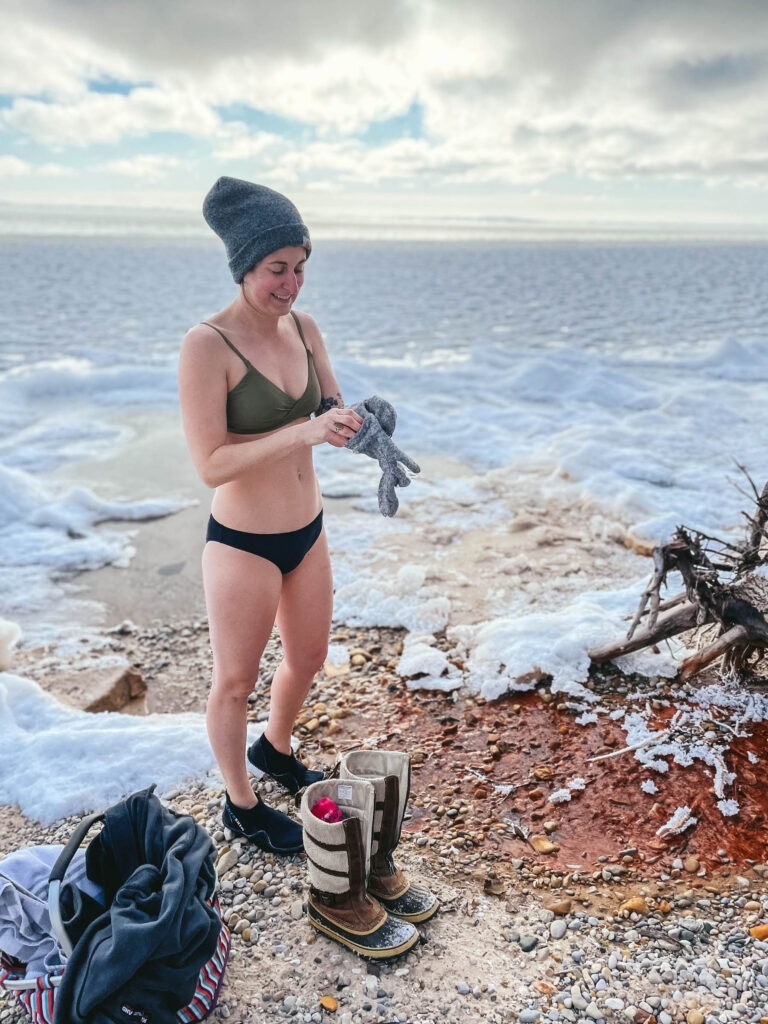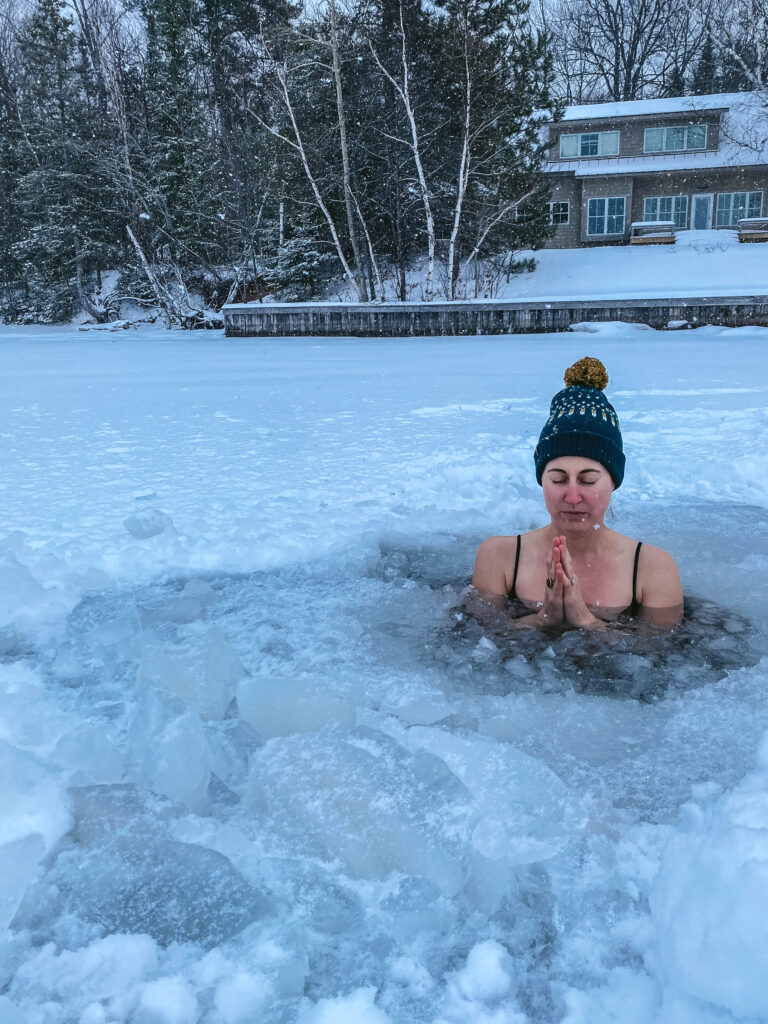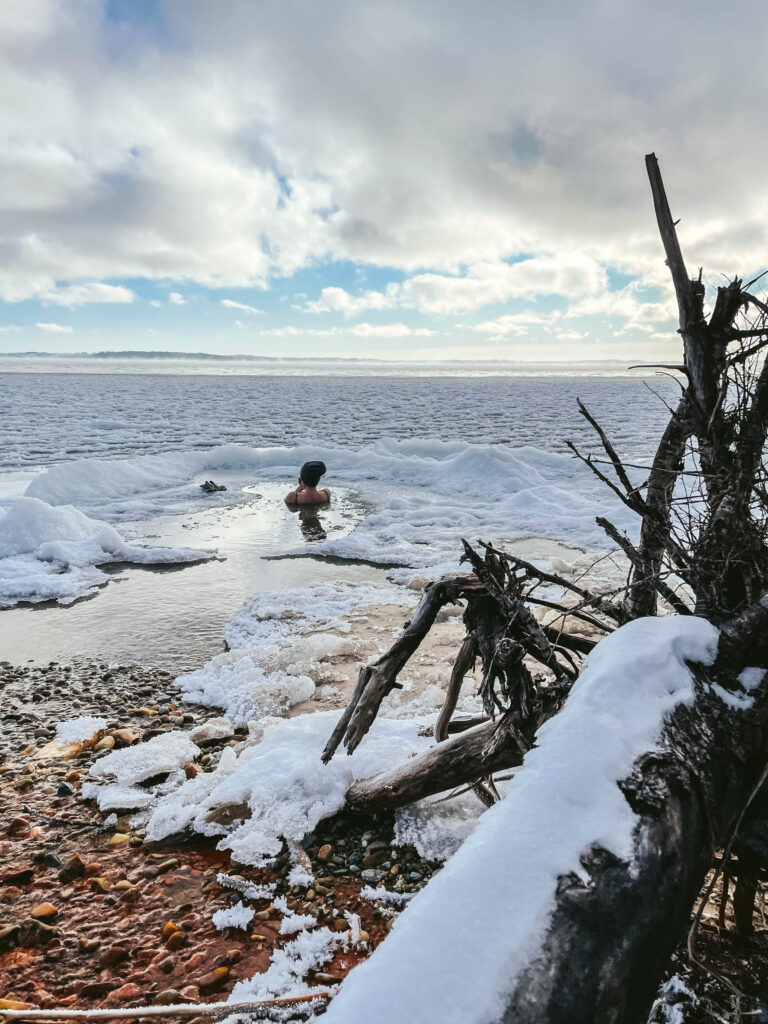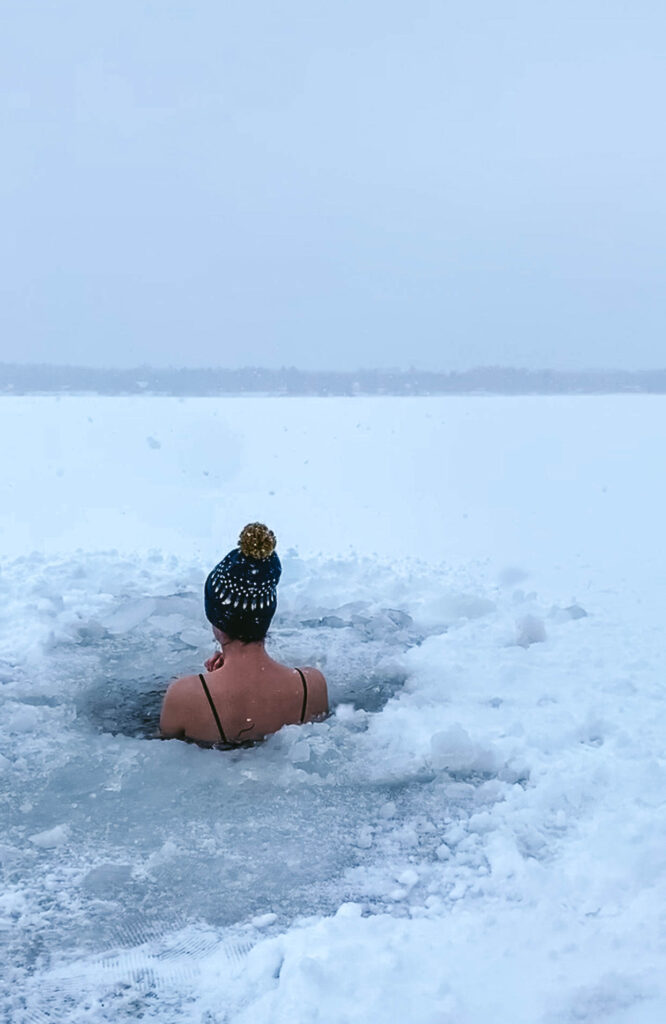I have been practicing cold water therapy for rheumatoid arthritis for over seven months. I continue to practice cold water immersion for the health benefits. Here is the second part of my series discussing the health benefits of cold water immersion and my tips and tricks to get you started.
Some links may be affiliate links. I may get paid if you buy something or take action after clicking one of these. If you do decide to buy, thank you! Your purchase allows me to continue sharing healthy and delicious recipes!

Jump to:
I have been weightless in your waves when I needed carrying the most.
Mae Stier from Letters to Lake Michigan
You can read my first blog post on why I started cold water swimming for rheumatoid arthritis here.
This past August, my journey practicing cold water therapy for rheumatoid arthritis started with me swimming in Lake Michigan every day for 2-5 minutes. The goal was the acclimate my body to the cold water as the seasons changed. As the water temperature dropped, my body would adjust. Now that winter is over, the water temperature is as low as it will go, around 33 degrees Fahrenheit without freezing. I am now in maintenance mode. I no longer submerge myself in cold water for my chronic pain every day but rather take cold dips 4-5 days a week. My body is now acclimated to the cold water, so I feel there is no need to go daily to get all the benefits.
In February, the area where I have access to open water froze for a few weeks. With the warmer air temperatures and wind, the site will go from freezing to open water. Due to the inconsistency, I bought a small foldup portable tub that I could place on my outside deck and fill up with water. I allow it to sit outside until it reaches around 34 or 35 degrees, ideal for my cold water therapy. Having the tub has been a great convenience to my wellness routine. I will use this tub when the lake is too warm for a cold water dip throughout the summer.

Water therapy for rheumatoid arthritis
Water therapy has been around for millennia. The act of humans exposing themselves to various water temperatures is well studied [1] for health.
Cold water therapy, also known as cryotherapy or cold water immersion, has been one of my favorite wellness practices to help my arthritis pain. While I enjoy cold water therapy for rheumatoid arthritis, different types of cold therapy are beneficial. Submerging yourself in cold water ranging from 33-55 degrees is good for the physical body and the mind.
Examples of cold therapy:
- Cold showers
- Ice baths
- Cold water immersion in a lake or tub
- Cryotherapy chambers with -166 to -222 degrees Fahrenheit. You can also explore the benefits of a cold plunge when it comes to overall health and well-being. The cold water can reduce inflammation, promote muscle recovery, and increase mental clarity. This is especially helpful for those with rheumatoid arthritis as it can help alleviate joint pain and stiffness.
Health benefits of cold water therapy
Physiological benefits
Living with rheumatoid arthritis or an autoimmune disease is a daily struggle of grieving our old selves, caring for our current body and mental state, and coping with anxiety about not knowing what the future holds. I feel I have been robbed of one area of my life is my joy. My day is filled with so many uncertain emotions that it feels like the joy, happiness, and love for my life have slowly slipped away. The hardest part about this is I have no other reason to feel that way. I am married to my dream man, I have two healthy children, I have so much support from friends and family, and we have a great home and are financially stable and abundant. In general, I have no stressors outside of chronic pain.
When getting into cold water, all of these emotions emerge. I feel the grief, the anxiety, and even the joy, the happiness, and love. The cold water is where I go to sort out these emotions. I enter the water and say my prayers, and the grief and anxiety state fade away. Once I sit and focus, the joy, happiness, and love circle and swirl through my body. Once I get out of the water, my body is invigorated. I smile, let out a large breath of relief, and feel how strong my body is. Dealing with these emotions and coming face to face with my daily challenges, and leaving feeling refreshed and energetic have been one of the most incredible benefits of my cold water practice. Anyone with depression, anxiety, or struggling with their current state of the unknown would benefit from this practice [2], in my opinion.
Swollen and inflamed joints from arthritis
While the mental health side has been a significant benefit in my cold water swimming, I will not forget about the physical benefits I have experienced. Living with rheumatoid arthritis means chronic pain, swollen and tender joints, damaged and eroded joints and cartilage, and inflammation and painful joints.
When I get into the water, I submerge my body up to my neck. I am blessed that my arthritis does not affect my larger joints as often as my hands and feet. My left shoulder gives me trouble, so I like to submerge my shoulders in the water. Almost instantly, I feel relief. The cold water, which acts the same as an ice pack on a joint, decreases inflammation and pain experienced in the joints. This is consistent with clinical research [3], suggesting inflammation and increase in mobility last around 90 minutes after treatment. While some feel it is counterproductive to have joints feel cold and stiff, once I warm up, my joints become more mobile and less tender and stiff. The temporary stiffness from the cold is worth it for me.
Boost the immune system
A clinical trial [4] consisting of over 3000 participants showed consecutive cold showers reduced the amount of sick leave taken from work by 29%.
Relieve muscle soreness
A study [5] performed in 2014 concluded that the use of cold water therapy after high-intensity workouts delayed the onset of muscular soreness.
I love to take a cold water plunge after my morning workouts. My core body temperature has increased, and getting into cold water feels tolerable and enjoyable.
Help with weight loss
When your body temperature cools, your body burns energy to warm you up. Simply put, your body’s fat is the fuel used for this process. This process is called thermogenesis [6].

Cold and heat therapy
One of my favorite practices is to alternate cold and heat therapy. My favorite way to do this is with a sauna and cold water. Cold decreases blood flow reducing inflammation and pain, while heat will increase blood flow, bringing nutrients to areas of the body and helping to speed up healing.
The after-drop
After practicing cold water therapy in very low temperatures, it is essential to fight the urge to take a shower right away. When we expose ourselves to such low temperatures, the warm blood leaves our extremities and moves to our core or vital organs. When we take a hot shower, our extremities warm, bringing cold blood back to other body areas. This is called the after-drop [7].
Long-distance outdoor swimmers frequently experience this. When this happens, we risk passing out. From experience, I know this can happen and how easily it can happen. I stayed in the water for over 4 minutes and immediately took a hot shower. I felt dizzy and lightheaded and knew I didn’t have time to get out of the shower, so I sat on the shower floor and took some breaths. While I did not pass out, I came very close. This is something to be very aware of, and it is recommended to allow your body to be regulated first. After a cold dip, taking a hot sauna is not the same since the air has to work longer to heat the body.
Tips and tricks for cold water immersion
If you feel inspired and want to try cold water swimming, here are some tips and tricks that I have picked up. As you embark on your cold water swimming journey, you will find what works for you.
Move
I feel like I have to move in the water. While some like to sit and soak (and I do this at times), movement helps me. It helps keep my mind focused on the water, but I also enjoy feeling the waves and water movement around my body.
If you are in the cold water swimming in a lake, allow your legs and hips to acclimate for 10-30 seconds before submerging your chest. It releases the initial shock, and when you finally lower into the water, the surprise is less. This is just my opinion and what works for me. Others like to submerge themselves immediately.
What to do with your hands
Our feet and hands are the first areas of the body to become cold. This is because the blood is rushing away from our extremities to keep our vital organs warm and safe. If you have a hard time keeping your hands in the water for the duration of your soak, here are a few techniques to help keep your hands a little warmer:
- Place your hands on your thighs. The small amount of heat from your thighs will keep the palms of your hands and fingers slightly warmer, allowing the fingers, hands, and wrists still to get the healing benefits of the cold water.
- Place your fingers under your armpits. This will allow your fingertips to stay warm but allow most of your hands and wrists to remain exposed to the water.
- Keep your hands out of the water in a prayer position. Your hands will not get the benefits of the cold water if they are left above the water. Since I have arthritis, my hands stiffen up fairly quickly. Since mid-December, I have swum this way. The cold air is enough of a temperature drop for them and not getting them wet helps me put my clothes on after my soak.
Wear neoprene gloves. I do not wear gloves, but I have friends that wear neoprene gloves for a similar idea of wearing booties. The gloves protect the fingers from too much cold. The gloves still allow cold to circulate throughout the glove but at slightly higher temperatures to reduce stiffness.
Wear neoprene booties or water shoes
During the wintertime, ice will build upon the shores of the lake, making it difficult to get to open water safely. I like to wear neoprene booties that have a grip on their bottom. They are not waterproof or so tight that they do not let water in. I still get to feel all the benefits of the cold water.

Preparing for a cold water plunge
Be prepared for when you get out of the water. Have a towel and either a robe or change of clothes ready. I put a towel and a robe in a small basket or bag to keep them clean and free from snow.
Have a cup of tea or hot water ready. I enjoy making a thermos of hot herbal tea or lemon water to enjoy afterward. The tea slowly warms the body, but this is not necessary.
Lastly, be smart. Always have someone with you while you plunge into cold water. Ideally, this person is a strong swimmer and can get you to dry land safely if needed. 99% of the time, someone is with me while I take my cold dips.
How long do I need to stay in cold water to get the benefits?
There is no correct answer to this question. While I wear a watch and time myself to see how my tolerance has built up over time, timing is not the answer. Connecting and being in tune with your body is more important than time. Our bodies can withstand stressors differently every day. I can soak in cold water for 5 minutes; it’s 1 minute on other days. It is crucial to let the ego go and practice intuitive cold water therapy. Your body will tell you when it’s time to get out.
Summer is approaching, but I plan on continuing my cold water therapy for rheumatoid arthritis in my portable tub. The health benefits I have experienced for my rheumatoid arthritis are too great.
Have you tried cold water therapy? What was your experience? Let me know in the comments below!

References:
[1]: https://www.ncbi.nlm.nih.gov/pmc/articles/PMC4049052/
[2]: https://pubmed.ncbi.nlm.nih.gov/17993252/
[3]: https://pubmed.ncbi.nlm.nih.gov/10832164/
[4]: https://www.ncbi.nlm.nih.gov/pmc/articles/PMC5025014/
[5]: https://pubmed.ncbi.nlm.nih.gov/25375114/
[6]: https://www.ncbi.nlm.nih.gov/pmc/articles/PMC3064898/
[7]: https://www.outdoorswimmingsociety.com/warming-up-after-drop/


This was a great read, thank you for sharing! I just purchased a plunge tub hoping to find the same relief you did. Thanks again!
I'm so happy to hear that!
I recently read an article on https://arcticplungegear.com/ discussing the benefits of cold water therapy for rheumatoid arthritis. They mentioned that regular cold plunges can help reduce inflammation and alleviate joint pain. Is this consistent with your experience? I’d love to hear your thoughts on how cold water immersion has impacted your rheumatoid arthritis symptoms.
This is such an insightful take on cold water therapy for rheumatoid arthritis! I’ve been researching this topic a lot lately, and I came across an article on https://arcticplungegear.com/ that discussed some potential considerations for people with joint conditions. It’s interesting how there are different perspectives on this, and I’d love to hear your thoughts on how to navigate the benefits and any possible risks.